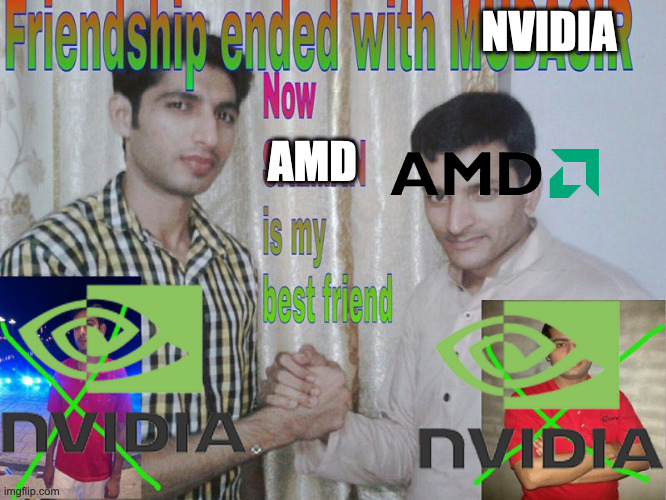TLDR: From my experience, in 2023, the Mesa drivers with an AMD GPU provide an experience that is way better than NVIDIA with their proprietary drivers. And if you're helping a friend get into linux, and or linux gaming I think you should steer them towards an AMD GPU.
"It just works", is how I would describe my computer after making the switch to an AMD GPU.
Having migrated from Windows I came over with an NVIDIA GPU, and for a long while my experience with using the proprietary NVIDIA drivers was fine. I had started with Manjaro, then moved to EndeavourOS after getting tired of Manjaro forgetting to renew their keys. EndeavourOS was an order of magnitude better, but eventually I got tired of tending to Arch and settled onto Fedora. Everything worked well enough so when I upgraded away from a 2070 Super I sought out a 3080 Ti, and again things were smooth. Issues didn't start cropping up until I upgraded monitors.
I went from 2560x1440@144hz to 3440x1440@240hz and on Fedora running under Wayland I could only get a max of 144hz. I tried using both HDMI and Displayport and could never budge past 144hz. Another issue that arose was I would need to manually turn my monitor on before booting my computer, otherwise I would not get an image, this was also the case for waking the computer having to manually turn on the monitor. Even after a fresh install of Fedora 38 these issues persisted.
Eventually I got tired of the issues I was experiencing on Fedora and decided to just try vanilla Arch. Using archinstall I was up and running with in no time, and to my surprise I was getting 240hz under X11 and Wayland. Tearing, and stuttering on X was detracting too much from the whole experience, so naturally I wanted to use Wayland.
Having gone with Gnome the amount of work required from my end to use Wayland was just too high. Even after getting the Wayland session up and running I still noticed odd graphical glitches, with enough frequency that I couldn't just live with them.
Eventually my 7900 XTX arrived, did a clean install with archinstall, and that's that. Everything just worked out of the box. It was refreshing that config changes I made were only because I wanted to, and not to enable basic functionality.
As a nice bonus seeing Processing Vulkan Shaders has become a rare occurrence after switching.

If Linus would be a non-techie, he would have tried to install it with a graphical AppStore, it wouldn't have worked and he'd either given up or found the flatpak version of Steam, which would have worked. Not restricting power users is a good aspect. If I play around with Windows registry to force the removal of edge, Linus would blame me, not Windows. You have to differentiate between things normal users tried and things Linus attempted because he has some technical knowledge.
Some random user saying anything doesn't make anything true, you don't believe flat-earthers on the internet, either.
@bionade24 @miggs597 @F04118F @JasSmith I'm a bit out of the loop here, but what was the bug actually? Did he do this on livestream?
There was a library incompatibility between the Steam image in the Pop_OS package manager and the OS. It was caused by a bug introduced by the Pop_OS developers. Linus tried to install Steam using the package manager and it failed. So he went on Google to find out how to install Steam on Pop_OS. A thousand blogs and forums told him to enter "sudo apt-get install Steam", which he did. Unfortunately doing so automatically uninstalls certain important desktop components in Pop_OS.
It wasn't on livestream, but you can see the process here: https://youtu.be/0506yDSgU7M?t=581
@JasSmith @miggs597 @F04118F @bionade24 lol, that's completely hilarious imo. Still though, that bug is definitely weird, I never got it my self on ubuntu or any of its derivatives. Is it only a pop OS issue then?